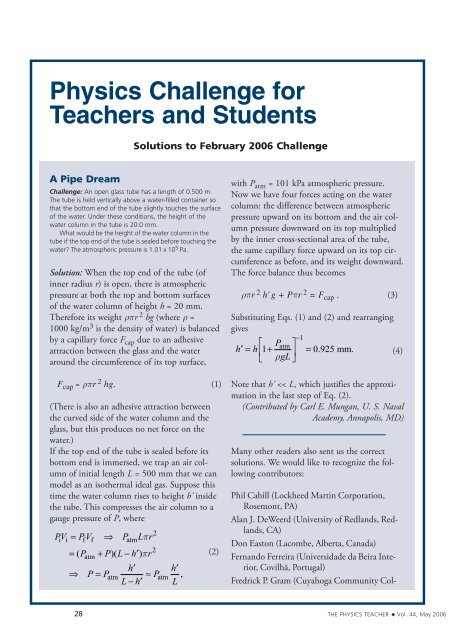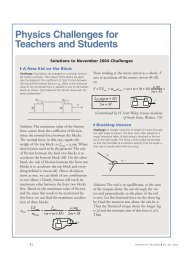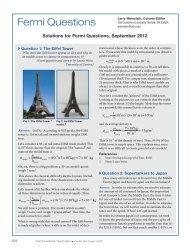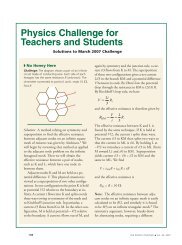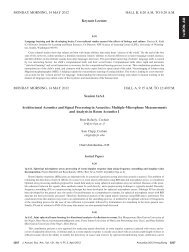February - Scitation
February - Scitation
February - Scitation
Create successful ePaper yourself
Turn your PDF publications into a flip-book with our unique Google optimized e-Paper software.
Physics Challenge for<br />
Teachers and Students<br />
A Pipe Dream<br />
Challenge: An open glass tube has a length of 0.500 m.<br />
The tube is held vertically above a water-filled container so<br />
that the bottom end of the tube slightly touches the surface<br />
of the water. Under these conditions, the height of the<br />
water column in the tube is 20.0 mm.<br />
What would be the height of the water column in the<br />
tube if the top end of the tube is sealed before touching the<br />
water? The atmospheric pressure is 1.01 x 10 5 Pa.<br />
Solution: When the top end of the tube (of<br />
inner radius r) is open, there is atmospheric<br />
pressure at both the top and bottom surfaces<br />
of the water column of height h = 20 mm.<br />
Therefore its weight ρπr 2 hg (where ρ =<br />
1000 kg/m 3 is the density of water) is balanced<br />
by a capillary force F cap due to an adhesive<br />
attraction between the glass and the water<br />
around the circumference of its top surface,<br />
F cap = ρπr 2 hg. (1)<br />
(There is also an adhesive attraction between<br />
the curved side of the water column and the<br />
glass, but this produces no net force on the<br />
water.)<br />
If the top end of the tube is sealed before its<br />
bottom end is immersed, we trap an air column<br />
of initial length L = 500 mm that we can<br />
model as an isothermal ideal gas. Suppose this<br />
time the water column rises to height h' inside<br />
the tube. This compresses the air column to a<br />
gauge pressure of P, where<br />
PV i i = PfVf ⇒ PatmLπr = ( P + P)( L− h′ ) πr<br />
atm<br />
⇒ P= P<br />
Solutions to <strong>February</strong> 2006 Challenge<br />
2<br />
2<br />
h′<br />
P<br />
L− h′<br />
≈<br />
atm atm<br />
h′<br />
,<br />
L<br />
(2)<br />
with P atm = 101 kPa atmospheric pressure.<br />
Now we have four forces acting on the water<br />
column: the difference between atmospheric<br />
pressure upward on its bottom and the air column<br />
pressure downward on its top multiplied<br />
by the inner cross-sectional area of the tube,<br />
the same capillary force upward on its top circumference<br />
as before, and its weight downward.<br />
The force balance thus becomes<br />
ρπr 2 h' g + Pπr 2 = F cap . (3)<br />
Substituting Eqs. (1) and (2) and rearranging<br />
gives<br />
⎡ ⎤<br />
′ = ⎢ + ⎥ (4)<br />
⎣ ⎦<br />
=<br />
−1<br />
Patm<br />
h h 1 0. 925 mm.<br />
ρgL<br />
Note that h'
lege, Cleveland, OH)<br />
Art Hovey (Milford, CT)<br />
José Costa Leme (High School Lanheses, Viana<br />
do Castelo, Portugal)<br />
Stephen McAndrew (Trinity Grammar School,<br />
Summer Hill, NSW, Australia)<br />
Leo H. van den Raadt (Heemstede, The Netherlands)<br />
Many thanks to all contributors and we hope to<br />
hear from you in the future!<br />
Please send correspondence to:<br />
Boris Korsunsky<br />
444 Wellesley St.<br />
Weston, MA 02493-2631<br />
korsunbo@post.harvard.edu<br />
THE PHYSICS TEACHER ◆ Vol. 44, May 2006 29


